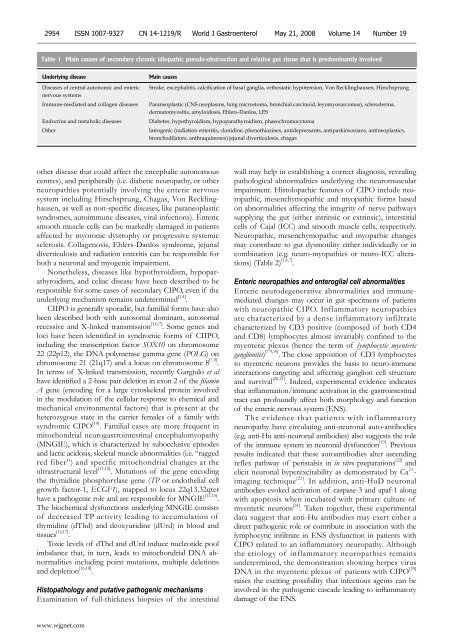Tradition or evidence based practice? - World Journal of ...
Tradition or evidence based practice? - World Journal of ...
Tradition or evidence based practice? - World Journal of ...
You also want an ePaper? Increase the reach of your titles
YUMPU automatically turns print PDFs into web optimized ePapers that Google loves.
2954 ISSN 1007-9327 CN 14-1219/R W<strong>or</strong>ld J Gastroenterol May 21, 2008 Volume 14 Number 19<br />
Table 1 Main causes <strong>of</strong> secondary chronic idiopathic pseudo-obstruction and relative gut tissue that is predominantly involved<br />
Underlying disease Main causes<br />
Diseases <strong>of</strong> central autonomic and enteric<br />
nervous systems<br />
other disease that could affect the encephalic autonomous<br />
centres), and peripherally (i.e. diabetic neuropathy, <strong>or</strong> other<br />
neuropathies potentially involving the enteric nervous<br />
system including Hirschsprung, Chagas, Von Recklinghausen,<br />
as well as non-specific diseases, like paraneoplastic<br />
syndromes, autoimmune diseases, viral infections). Enteric<br />
smooth muscle cells can be markedly damaged in patients<br />
affected by myotonic dystrophy <strong>or</strong> progressive systemic<br />
sclerosis. Collagenosis, Ehlers-Danlos syndrome, jejunal<br />
diverticulosis and radiation enteritis can be responsible f<strong>or</strong><br />
both a neuronal and myogenic impairment.<br />
Nonetheless, diseases like hypothyroidism, hypoparathyroidism,<br />
and celiac disease have been described to be<br />
responsible f<strong>or</strong> some cases <strong>of</strong> secondary CIPO, even if the<br />
underlying mechanism remains undetermined [1,4] .<br />
CIIPO is generally sp<strong>or</strong>adic, but familial f<strong>or</strong>ms have also<br />
been described both with autosomal dominant, autosomal<br />
recessive and X-linked transmission [1,6,7] . Some genes and<br />
loci have been identified in syndromic f<strong>or</strong>ms <strong>of</strong> CIIPO,<br />
including the transcription fact<strong>or</strong> SOX10 on chromosome<br />
22 (22p12), the DNA polymerase gamma gene (POLG) on<br />
chromosome 21 (21q17) and a locus on chromosome 8 [7-9] .<br />
In terms <strong>of</strong> X-linked transmission, recently Gargiulo et al<br />
have identified a 2-base pair deletion in exon 2 <strong>of</strong> the filamin<br />
A gene (encoding f<strong>or</strong> a large cytoskeletal protein involved<br />
in the modulation <strong>of</strong> the cellular response to chemical and<br />
mechanical environmental fact<strong>or</strong>s) that is present at the<br />
heterozygous state in the carrier females <strong>of</strong> a family with<br />
syndromic CIPO [10] . Familial cases are m<strong>or</strong>e frequent in<br />
mitochondrial neurogastrointestinal encephalomyopathy<br />
(MNGIE), which is characterized by subocclusive episodes<br />
and lactic acidosis, skeletal muscle abn<strong>or</strong>malities (i.e. “ragged<br />
red fiber”) and specific mitochondrial changes at the<br />
ultrastructural level [11,12] . Mutations <strong>of</strong> the gene encoding<br />
the thymidine phosph<strong>or</strong>ylase gene (TP <strong>or</strong> endothelial cell<br />
growth fact<strong>or</strong>-1, ECGF1), mapped to locus 22q13.32qter<br />
have a pathogenic role and are responsible f<strong>or</strong> MNGIE [11-15] .<br />
The biochemical dysfunctions underlying MNGIE consists<br />
<strong>of</strong> decreased TP activity leading to accumulation <strong>of</strong><br />
thymidine (dThd) and deoxyuridine (dUrd) in blood and<br />
tissues [16,17] .<br />
Toxic levels <strong>of</strong> dThd and dUrd induce nucleotide pool<br />
imbalance that, in turn, leads to mitochondrial DNA abn<strong>or</strong>malities<br />
including point mutations, multiple deletions<br />
and depletion [16,18] .<br />
Histopathology and putative pathogenic mechanisms<br />
Examination <strong>of</strong> full-thickness biopsies <strong>of</strong> the intestinal<br />
Stroke, encephalitis, calcification <strong>of</strong> basal ganglia, <strong>or</strong>thostatic hypotension, Von Recklinghausen, Hirschsprung<br />
Immune-mediated and collagen diseases Paraneoplastic (CNS neoplasms, lung microstoma, bronchial carcinoid, leyomyosarcomas), scleroderma,<br />
dermatomyositis, amyloidosis, Ehlers-Danlos, LES<br />
Endocrine and metabolic diseases Diabetes, hypothyroidism, hypoparathyroidism, phaeochromocytoma<br />
Other Iatrogenic (radiation enteritis, clonidine, phenothiazines, antidepressants, antiparkinsonians, antineoplastics,<br />
bronchodilat<strong>or</strong>s, anthraquinones) jejunal diverticulosis, chagas<br />
www.wjgnet.com<br />
wall may help in establishing a c<strong>or</strong>rect diagnosis, revealing<br />
pathological abn<strong>or</strong>malities underlying the neuromuscular<br />
impairment. Histolopathic features <strong>of</strong> CIPO include neuropathic,<br />
mesenchymopathic and myopathic f<strong>or</strong>ms <strong>based</strong><br />
on abn<strong>or</strong>malities affecting the integrity <strong>of</strong> nerve pathways<br />
supplying the gut (either intrinsic <strong>or</strong> extrinsic), interstitial<br />
cells <strong>of</strong> Cajal (ICC) and smooth muscle cells, respectively.<br />
Neuropathic, mesenchymopathic and myopathic changes<br />
may contribute to gut dysmotility either individually <strong>or</strong> in<br />
combination (e.g. neuro-myopathies <strong>or</strong> neuro-ICC alterations)<br />
(Table 2) [1,6,7] .<br />
Enteric neuropathies and enteroglial cell abn<strong>or</strong>malities<br />
Enteric neurodegenerative abn<strong>or</strong>malities and immunemediated<br />
changes may occur in gut specimens <strong>of</strong> patients<br />
with neuropathic CIPO. Inflammat<strong>or</strong>y neuropathies<br />
are characterized by a dense inflammat<strong>or</strong>y infiltrate<br />
characterized by CD3 positive (composed <strong>of</strong> both CD4<br />
and CD8) lymphocytes almost invariably confined to the<br />
myenteric plexus (hence the term <strong>of</strong> lymphocytic myenteric<br />
ganglionitis) [7-9,19] . The close apposition <strong>of</strong> CD3 lymphocytes<br />
to myenteric neurons provides the basis to neuro-immune<br />
interactions targeting and affecting ganglion cell structure<br />
and survival [20,21] . Indeed, experimental <strong>evidence</strong> indicates<br />
that inflammation/immune activation in the gastrointestinal<br />
tract can pr<strong>of</strong>oundly affect both m<strong>or</strong>phology and function<br />
<strong>of</strong> the enteric nervous system (ENS).<br />
The <strong>evidence</strong> that patients with inflammat<strong>or</strong>y<br />
neuropathy have circulating anti-neuronal auto-antibodies<br />
(e.g. anti-Hu anti-neuronal antibodies) also suggests the role<br />
<strong>of</strong> the immune system in neuronal dysfunction [19] . Previous<br />
results indicated that these autoantibodies alter ascending<br />
reflex pathway <strong>of</strong> peristalsis in in vitro preparations [22] and<br />
elicit neuronal hyperexcitability as demonstrated by Ca 2+ -<br />
imaging technique [23] . In addition, anti-HuD neuronal<br />
antibodies evoked activation <strong>of</strong> caspase-3 and apaf-1 along<br />
with apoptosis when incubated with primary culture <strong>of</strong><br />
myenteric neurons [24] . Taken together, these experimental<br />
data suggest that anti-Hu antibodies may exert either a<br />
direct pathogenic role <strong>or</strong> contribute in association with the<br />
lymphocytic infiltrate in ENS dysfunction in patients with<br />
CIPO related to an inflammat<strong>or</strong>y neuropathy. Although<br />
the etiology <strong>of</strong> inflammat<strong>or</strong>y neuropathies remains<br />
undetermined, the demonstration showing herpes virus<br />
DNA in the myenteric plexus <strong>of</strong> patients with CIPO [25]<br />
raises the exciting possibility that infectious agents can be<br />
involved in the pathogenic cascade leading to inflammat<strong>or</strong>y<br />
damage <strong>of</strong> the ENS.

















